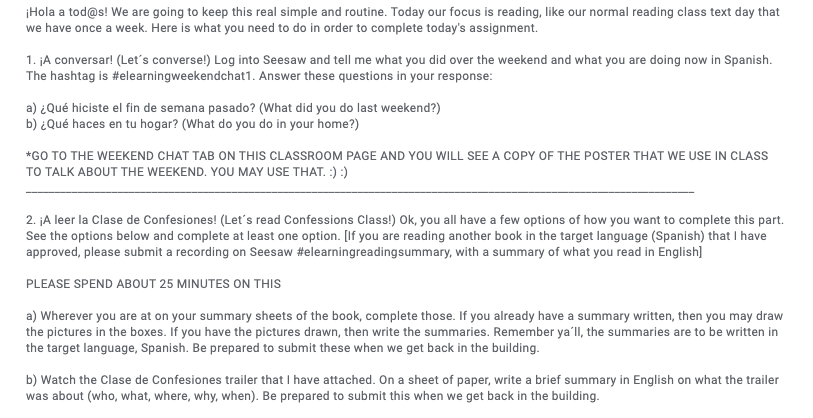Hi all! If you are anything like me, the sudden urgency to e-learning
from teaching in the classroom has been a transition. I started the
first three days of online learning (our spring break started Friday,
March 20th), and I thought to myself, Ok this isn’t bad at all. However,
the thought of having to do this for real for the next month has not
exactly set in. For some reason, I am still waiting for someone to
say, “Just kidding. Let’s head back to our classrooms!”
The fact of the matter is that this is real, and for those of us who are classroom teachers first, we are embarking in unknown territory. The awesome news is that we are all already gifted and have a passion to teach! WE CAN DO THIS! So, here I am going to share my 7 go-to equitable strategies for e-learning that will help support you in your journey of online teaching.
STUDENT CHOICE
I give them a choice on which activities they can complete for assignments on a consistent basis throughout the week. When we were in the classroom, Fridays were known as choice days. Here is a picture of what I’ve done so far for e-learning.

BRAIN BREAKS
As my colleagues Ashley Uyaguari and Sarah Breckley have demonstrated to us within the language community, planned brain breaks are wonderful in the classroom! Not only does it give my students a movement break, but it re-energizes them as well. They’re even better online and are tons of fun! For more information on brain breaks, I encourage you to follow them (by clicking on their names above) on Twitter.

HOLD UP! ON THE AMOUNT OF CONTENT
E-learning is new for all of my students. I have been adjusting the length of my assignments in order for them to be completed within a 25 minute time frame. I also am being mindful of other content areas in which my students have to complete, as well as how long it will take for me to assess their online assignments. As I put on my mom/teacher hat, I have a responsibility to strategically balance my family’s needs and the needs of my students. My oldest daughter also has e-learning assignments that require guidance and support.
GIVE GRACE
Every student lives in a household with their own family’s routines and expectations. I try to be mindful that the tasks I assign online will be prioritized according to that student’s family’s expectations and needs. I know that not all of my students logged on for e-learning the first week, so on the day before their spring break, the first task was for my students to finish any previous assignments. I am leaving those previous assignments as posted for those that need to complete or will be completing the tasks after spring break.
CULTURALLY/RACIALLY/ETHNICALLY DIVERSE REPRESENTATION AND INTERCULTURAL COMPETENCE
If you are using short stories, depending on the topic, make sure they are of equitable content presented in an authentic non-biased way. Make it a priority to avoid stereotypes that are often perpetuated onto certain groups of people, and be mindful of the author’s perspective. I encourage you to follow Dorie CP on Twitter and/or check out her website aglobalclassroom.com. She can provide you with more information on the subject of intercultural competence.
SLOW AND STEADY WINS THE RACE
Take it one day at a time. This is not a sprint. Everyone is in different places of their journey of teaching. A strategy that has helped me, is beginning with what my students are familiar with, within the realm of technology i.e. Google Classroom, Flipgrid, Seesaw, Gimkit, and Quizlet. I like to and am planning on keeping it simple, effective, and productive. When I feel that I am ready to add an additional technology instructional tool to further support my students’ online experiences, I will do so, but a bit at a time.
CHECK INS
I plan to schedule some time via video conference to check in with my students. For me most likely it will be about 5-10 minutes to chat about whatever is on their minds, whether or not they have questions on upcoming assignments, something funny to share that happened over their spring break, or even if there are questions about when they will be returning to school. This is a great way to maintain the community that we’ve all established in our classrooms.
I hope this was encouraging and that you grabbed some takeaways. For more technology resources, connect with Rachel Lucas, Spanish teacher and Ed Tech. Coach´s Tech for World Language Teachers Community and Tech for World Language Teachers Blog. Feel free to access her Facebook group here or request to join the private group for teachers.
Remember, we’re all in this together. Keep going and growing! Until next time ya’ll!!
Kia
#journeywithequity
P.S. For more encouragement during this time, check out Spanish Teacher, Jahdai’s, recent podcast episode “Mensajes Positivos en los tiempos extraños” of What in the World Language? Language Podcast. You will be encouraged! 🙂

